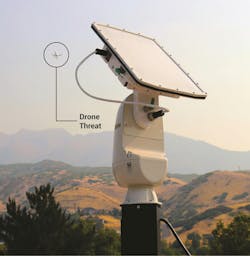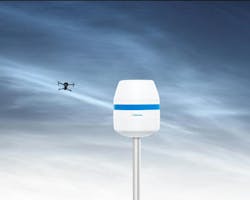Tech Trends: Add Drone Detection to your Offerings
This article originally appeared in the January 2024 issue of Security Business magazine. Don’t forget to mention Security Business magazine on LinkedIn and @SecBusinessMag on Twitter if you share it.
In the fast-evolving landscape of security technology, the rise of Unmanned Aircraft Systems (UAS) – drones – presents a new set of challenges and opportunities.
Drones, ranging from small recreational quadcopters to sophisticated unmanned aerial vehicles (UAVs), have become ubiquitous. While these devices offer numerous benefits, they also pose security risks. Unauthorized drone flights can compromise sensitive areas, engage in espionage, or even carry out malicious activities.
As drones become increasingly prevalent, the demand for effective drone detection systems is on the rise. Security integrators are well-positioned to meet this demand, and they can not only enhance safety and security with comprehensive solutions that safeguard against the potential threats posed by drones, but they can also tap into a lucrative recurring revenue market.
Let’s examine the significance of drone detection systems and how security integrators can profit from installing and maintaining these cutting-edge solutions.
Drone Detection Technology: Multiple Pathways to Success
Drone detection systems are designed to identify, track, and respond to the presence of drones within a given area. These systems leverage a combination of sensors, cameras, and communication technologies to detect the unique signatures emitted by drones. The seamless integration of drone detection systems with existing security infrastructure is crucial. This includes integration with video management systems, access control systems, and alarm systems. By providing a unified security platform, security integrators can offer clients a comprehensive solution to address multiple security concerns.
Each solution tends to rely on a different underlying technology, as outlined below; however it is important to note that while any one system can be effective, a combination of systems will increase the likelihood of detection in different scenarios.
Radar: Radar systems optimized for drone detection can track the movement of drones in real-time, providing crucial data on their location and trajectory. Advanced radar systems are essential for overcoming challenges associated with detecting small, low-flying objects against complex backgrounds. Spotter RF is a good example of a radar-based system (www.spotterrf.com/drone-detection).
RF sensors: Radio Frequency (RF) sensors, such as those from Dedrone (www.dedrone.com), intercept and analyze communication signals between a drone and its operator. This approach helps in identifying unauthorized drones and their operators. Security integrators can incorporate these sensors into comprehensive detection solutions.
Optical and infrared cameras: Visual and infrared cameras play a pivotal role in drone detection. These cameras capture images and heat signatures, enabling security personnel to visually identify drones. Integrating machine learning algorithms enhances the accuracy of detection and classification.
Acoustic Sensors: These sensors, such as the ones marketed by Squarehead Technology (www.sqhead.com) detect the distinctive sounds produced by drones. This adds an additional layer of detection, especially useful in scenarios where visual or RF-based detection may be challenging.
Profit Opportunities for Integrators
Security integrators and consultants can offer customers customized solutions for diverse needs, tailoring drone detection systems to meet the unique requirements of various industries. From critical infrastructure protection to event security and private property surveillance, offering specialized solutions enhances the value proposition for clients.
A comprehensive drone detection offering should include the following key aspects:
Consultation and risk assessment services: This is one way that security integrators can position themselves as experts in assessing and mitigating drone-related risks. By offering consultation services and conducting thorough risk assessments, integrators can identify vulnerabilities and recommend tailored drone detection solutions.
Installation and maintenance: The installation and ongoing maintenance of drone detection systems present a significant revenue stream for security integrators. This includes configuring sensors, cameras, and communication systems, as well as providing regular updates and troubleshooting services.
Training: As part of a comprehensive service offering, security integrators can develop training programs to educate clients' personnel on effectively using drone detection systems. This ensures optimal use and enhances the overall security posture of the client.
Regulatory knowledge: Keeping pace with regulatory compliance and staying informed about evolving regulations related to drone usage is crucial. Integrators can provide valuable insights into compliance requirements and assist clients in aligning their drone detection systems with relevant regulations.
The Next Steps
While the opportunities are vast, security integrators interested in adding drone detection to their suite of offerings must navigate certain challenges. Ensuring the reliability and accuracy of detection systems, addressing false positives, and staying abreast of technological advancements are essential. Building trust with clients by showcasing expertise, delivering on promises, and providing ongoing support is also a key to long-term success.
The drone detection landscape is dynamic, with continuous advancements in technology. Security integrators can stay competitive by fostering collaborations with technology developers, staying informed about emerging trends, and investing in research and development. By embracing innovation, security integrators can offer clients state-of-the-art solutions that keep pace with evolving drone threats.
Paul F. Benne is a 37-year veteran in the protective services industry. He is President of Sentinel Consulting LLC, a security consulting and design firm in based in New York City. Connect with him via LinkedIn at www.linkedin.com/in/paulbenne or visit www.sentinelgroup.us
About the Author

Paul F. Benne
Paul F. Benne is a 37-year veteran in the protective services industry. He is President of Sentinel Consulting LLC, a security consulting and design firm in based in New York City. Connect with him via LinkedIn at www.linkedin.com/in/paulbenne or visit www.sentinelgroup.us



